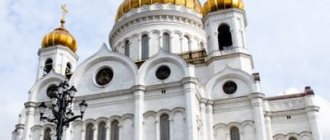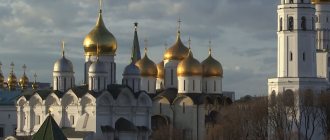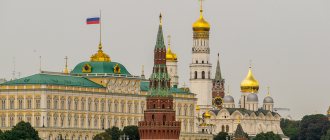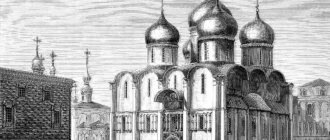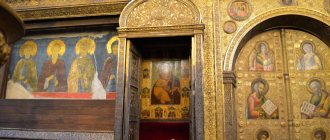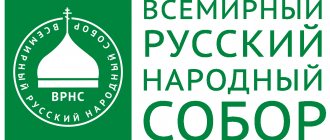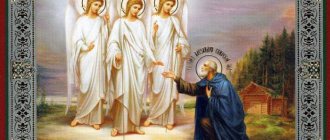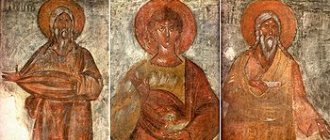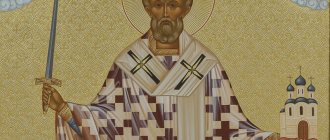History of the development of the iconostasis.
Also on the topic:
ORTHODOX WORSHIP
The formation of the iconostasis has a long history. In early Christian churches, the altar was separated from the temple itself by a woven curtain or barrier, which was either a low barrier wall or a series of columns with an architrave, which in the Byzantine tradition is usually called a templon. The oldest literary source reporting the existence of an altar barrier belongs to Eusebius of Caesarea (c. 260–340). He says that in the temple built in Tire in the 4th century, the altar was separated from the rest of the space by a carved fence. Considerably ancient, according to many researchers, is the use of woven curtains. By analogy with the curtain of the Old Testament temple, they separated the “Holy of Holies” of the church - the altar - from the place of meeting of believers, serving as an external sign of the hierarchy of parts of the temple. In the letters of the Apostle Paul, the Old Testament veil received a New Testament interpretation and was likened to the flesh of Christ, and therefore a cross began to be depicted on it, which later became an integral part of the decoration of the altar barriers.
Early Byzantine barriers consisted of marble barriers and columns carrying an architrave-templon decorated with an image of a cross. On the side of the altar behind it there was a curtain, which was drawn and drawn back at certain moments of the service. Such barriers, being an integral part of the architectural ensemble of the temple, highlighted the altar, emphasizing its significance as a place for performing the sacrament. Separating the altar from the naos, the curtain, barrier, and later the iconostasis served as the boundary between two worlds: the above and below, visible and invisible, and were intended to express their indissoluble connection. The material barrier symbolized the existence of an “immaterial iconostasis,” understood in the Orthodox tradition as a collection of saints, heavenly witnesses, proclaiming to the world what is “beyond the flesh.”
Also on topic:
ICON
The historical path of transforming the altar barrier into a high iconostasis is connected precisely with the consistent disclosure of this idea. Already in the 6th century. Emperor Justinian in the church of St. Sophia placed relief images of the Savior, the Mother of God, apostles and prophets on the templon of the altar barrier. In the post-iconoclast period, starting from the 9th century, the installation of icons on templons was already practiced quite widely. For the 12th century. the decoration of the Byzantine templon with a row of icons became ubiquitous. By this time, the iconostasis had taken the form of a portico with columns and free space between them. Icons were placed on a templon or hung from it. Sometimes large icons were placed in the intercolumnae of the portico. These were, as a rule, icons of the Savior, the Mother of God and the holy temple. Above the royal doors was placed the main icon - “Deisis” (Greek prayer, in Russian the word was fixed in the form “Deesis”), depicting on one board Christ and the Mother of God and John the Baptist addressed to him with prayer. The Byzantine barrier could have from one to three rows of icons, among which there were images of prophets and Christian holidays.
The type of altar barrier that developed in Byzantium passed to Rus', where it gradually underwent a number of significant changes that turned it into a high iconostasis. According to field studies in Russian churches of the 11th–12th centuries. There were two types of barriers - with a continuous templon, which covered the entire temple, and with a shortened templon, which covered only the central altar opening. Templon, in Russian translation “tyablo”, served primarily for fastening the curtains, which covered the entire altar space by almost half the height. The fundamental difference between both types and Byzantine barriers was the absence of columns in the composition and the installation of the templon at a considerable height. Subsequently, these features largely predetermined the transformation of the pre-Mongol barrier into a high iconostasis.
Also on topic:
ORTHODOX ICON
The high height of the templon and the absence of vertical divisions in Russian altar barriers provoked the filling of the void formed between the low barrier and the templon. The oldest monument known to us, in which an iconostasis was installed, consisting of a large-scale “Deesis” and the royal doors, dates back to 1360–1361 (the Church of Fyodor Stratilates on the Stream in Novgorod). Here, to fasten the Deesis, another lower panel appeared. In turn, the Byzantine templon turned into the upper table. There was no local row in this iconostasis.
Regarding the development of the Russian iconostasis in the 15th century. There are two hypotheses. According to the first, a high three-tiered iconostasis, including a Deesis rank, a festive and semi-figured prophetic row, was created in Moscow with the direct participation of Theophanes the Greek. According to the second hypothesis, the formation of the high iconostasis went through two stages. At the first stage, the iconostasis consisted of a Deesis and a festive row. In the 15th century In the workshop of Andrei Rublev, an iconostasis was created for the first time, including a semi-figured prophetic row. The emergence of a new type of iconostasis is associated with the hesychasm movement and the peculiarities of worship according to the Jerusalem Rule, introduced in Rus' by Metropolitan Cyprian.
In the 16th century a new row is added to the iconostasis - the forefathers' row. With its appearance, the classic type of five-tier iconostasis finally emerged. However, the increase in the number of rows and height of the iconostasis does not stop there.
Since the beginning of the 17th century. Above the ancestral row, a tier of images of seraphim and cherubim increasingly appears. In the second half of the 17th century. the so-called pyadnichnaya row (icons the size of a “span”, i.e. a hand). Presumably, its appearance is connected with the decision of the Council of 1666–1667, which condemned the practice of parishioners bringing their own icons to the temple, because of which “everyone prays to his own icon in different countries...”. The council decided to give the icons to the temple irrevocably, and, apparently, they began to be placed above the local row to ensure proper veneration of the images. In the second half of the 17th century. a passionate row (icons depicting the passion of Christ) appeared in the iconostasis, as well as a cross with the image of the Crucifixion crowning the iconostasis. Passionate icons were placed above all others and were usually enclosed in separate carved cartouches. The crucifix was picturesque, trimmed along the contour and enclosed in a frame of gilded carvings. At the end of the 17th - beginning of the 18th centuries. Iconostases decorated with rich wooden carvings became widespread, essentially turning into giant carved frames for icons. At the end of the 17th - beginning of the 18th centuries. under Russian influence, carved iconostases began to be made on Athos, Greece and the Balkans.
Is that what they call only a row in a church iconostasis?
The Deesis rank is not only a row in the temple iconostasis. Rather, the term denotes an artistic composition that expresses a specific meaning. This can be either a combination of many icons lined up in one row, or a long wall fresco. Of course, simple icons are also made in the same style and with a similar meaning.
Icon painting in the Deesis style arose due to the development of liturgy in Byzantine churches. This period was associated with the so-called time of iconoclasm. In the churches of Byzantium at that time, during services, a small icon with a Deesis plot was placed on the architrave of the altar barrier. As a rule, only the Lord himself, John the Baptist and the Mother of God were depicted on it. This was due to the fact that such content of the icon most accurately conveyed the essence of Christianity - forgiveness, intercession, love and mercy.
After the end of the era of iconoclasm, the Deesis genre remained one of the most popular. Small altar images developed into triptychs in homes and, of course, a whole series on Orthodox church iconostases.
Festive row.
The next tier of the iconostasis represents the New Testament period, namely the events associated with the earthly life of Christ. However, the holiday series is not a consistent illustration of the gospel story. Its content was determined by the context of the iconostasis as a single whole, as well as by various nuances of understanding the daily, weekly and annual cycles of worship. In the festive series, only those events are depicted that are significant stages of the Divine economy of salvation. Usually this series consists of icons of the Resurrection, the main twelve feasts (Christmas, Epiphany, Presentation, Entry into Jerusalem, Ascension, Transfiguration, Nativity of the Virgin Mary, Presentation into the Temple, Annunciation, Dormition), as well as two ecclesiological holidays of the moving cycle: Pentecost and Exaltation of the Cross .
Addition[edit | edit code]
“Of course, the appearance in the iconostasis of a whole order of prophets (as well as the mention of the prophetic order in the 8th article of the Creed, established by the fathers of the Second Ecumenical Council) is undoubted evidence that the Church saw in the prophetic ministry not only a historical phenomenon, but also an immutable component salvation of man in the Church. Historically, the concept of prophetic ministry has undergone changes, but the importance of this calling has not been in doubt.”[2]
The prophetic row symbolizes the Church, which has already received the Law and through the prophets proclaims about the Mother of God, from whom Christ will be incarnate. “That is why in the center of this row there is the icon of the Sign, depicting the Mother of God with her hands raised in prayer and with the Infant God in her bosom.”[3].
The first example of a prophetic series is a multi-tiered iconostasis for the Assumption Cathedral of Vladimir in 1408 (or in 1410-11), whose creation is associated with the painting of the Assumption Cathedral by Daniil Cherny and Andrei Rublev[4]. The iconostasis has not been completely preserved; only two waist-length icons have survived from the prophetic series.
Early examples[edit | edit code]
- Iconostasis of the Assumption Cathedral in Vladimir - did not reach
- Iconostasis of the Assumption Cathedral on Gorodok in Zvenigorod - did not reach
- Iconostasis in the Trinity Cathedral of the Trinity-Sergius Lavra (1420s). The first one to survive. There are 12 prophets in this iconostasis: on the left side of the Mother of God, Solomon, Isaiah, Jeremiah, Gideon, Ezekiel, Habakkuk, on the right side - Moses, David, Joel, Jonah, Jacob, Daniel. The images are half-length, they are combined two on each board. The image of Our Lady of the Sign here dates back to the 18th century.
- Iconostasis of the Assumption Cathedral of the Great Tikhvin Monastery (GTG) - 16 prophets: Ezekiel, Elisha, Joel, Malachi, Gideon, Nahum, Zephaniah, David, Amos, Zechariah, Elijah, Jesse, Solomon, Micah, Isaiah; The icon depicting Daniel is missing.
- Prophetic series. Around 1502. From the Cathedral of the Nativity of the Virgin Mary in the Ferapontov Monastery. Museum of the Kirillo-Belozersky Monastery.
- Prophet Sophronia. 1408 or 1410s. Daniil, Andrey Rublev and the workshop (?). From the iconostasis of the Assumption Cathedral of Vladimir. timing belt
- Prophets Solomon and Isaiah. From the iconostasis of the Trinity-Sergius Cathedral of the Lavra, 1425-1427
- Daniel, David and Solomon (Novgorod, ca. 1497). Timing belt An example of early iconography, when the Virgin Mary was not yet placed in the center.
Deesis series.
The semantic center of this series is the icon of the Savior, represented, as a rule, in the image of a formidable Judge who appeared to judge the world. To the right and left of Jesus Christ are the Mother of God and John the Baptist. They are followed by archangels, saints, apostles, martyrs, saints, i.e. a host of saints, represented by all orders of holiness. The main theme of the Deesis rite is the church’s prayer for peace. Representatives of the earthly world who have achieved holiness and entered the Kingdom of Heaven, forming the Heavenly Church headed by Christ, prayerfully come before the throne of Christ the Judge, asking for leniency towards the earthly church gathered in the temple.
What does the name itself mean?
The semantic meaning of the word “deesis” is a request, prayer for something or someone. The main row of the iconostasis is named this way because it is executed in the traditional Orthodox style of prayerful intercession. All the minor figures turn their faces or even their bodies to God, they pray to him for mercy and forgiveness.
It is in the mediatorial prayer for forgiveness and mercy that the dogmatic meaning of the Deesis rite lies. The Mother of God and other saints pray to Jesus for the forgiveness of the human race; they embody intercession for the souls of people before the Lord's throne.
Royal Doors,
leading to the altar, are an integral part of the iconostasis and have existed since the time of the initial construction of the altar barrier. Already in the 5th–6th centuries. they were decorated with sacred images. Usually the “Annunciation” is placed on the royal doors, and under it the images of the four Evangelists. Symbolically, the royal doors mean the entrance to the Kingdom of God. The Annunciation marks the beginning of the salvation of mankind and at the same time embodies the very “message” that was announced to the world by the evangelists. Above the royal doors the “Communion of the Apostles” or “Eucharist” is depicted as a sign that the communion of priests takes place in the altar, and the communion of believers takes place on the salt in front of the royal doors.
In a symbolic sense, the iconostasis, like the temple, is an image of the church. However, if the temple is a liturgical space that includes a meeting of the faithful, then the iconostasis shows the formation of the church in time from Adam to the Last Judgment, representing an image of future communion with God in a new transformed world. The “Eucharist”, presented in the decoration of the royal doors, being an image of the saving event that once occurred at the Last Supper being renewed in the service, unites and covers all times, connects the temporary and the eternal, the earthly and the heavenly.
Iconography[edit | edit code]
The number of prophets depicted may vary depending on the size of the row. Until the 16th century The prophets were depicted half-length, and later - in full height. Initially, the prophets David and Solomon were placed in its center, from the 16th century. - usually an icon of the Mother of God of the Sign, “containing in Her bosom the image of the Son born of Her,” or the Mother of God with the Child on the throne (depending on whether the images of the prophets are half-length or full-length). “The image of the Mother of God with the Baby Emmanuel in her bosom marks the fulfillment of the predictions of the Old Testament forefathers and prophets and indicates a direct connection between the Old and New Testaments”[1]
Images of prophets are usually turned towards the center; however, if there are three prophets on the board, then the middle one can be written in front.
Usually prophets hold scrolls with the texts of their prophecies about the birth of the Savior.
Sometimes in the hands of the prophets the symbols and attributes of their prophecies given by them are depicted (for example, in Daniel - a stone that was independently torn from the mountain, like the image of Christ born of the Virgin, in Gideon a dew-drenched fleece, in Zechariah a sickle, in Ezekiel the closed gates of the temple) . Prophetic series. Around 1502. From the Cathedral of the Nativity of the Virgin Mary in the Ferapontov Monastery. Museum of the Kirillo-Belozersky Monastery.
| Prophets Zephaniah, Habakkuk, Jonah, Moses. | Prophets Daniel, Jeremiah, Isaiah | Our Lady of the Sign, prophet kings David and Solomon | Prophets Aaron, Gideon, Ezekiel | Prophets Jacob, Zechariah, Malachi, Joel. |
Portrayed prophets[edit | edit code]
not only “written prophets” are depicted - the authors of prophetic books (Great and Minor Prophets), but also kings David, Solomon, Elijah the prophet and other people associated with the foreshadowing of Christ.
- David
.
This is how the iconographic original describes him: “a type of Jew of Palestine, an old man of average height with a gray thick curly beard; clothing - chiton and mantle, crown on the head; signed: “Profit David”. The inscriptions on the scroll: “Hear, Daughter, and see, and incline Your ear, and forget Your people and Your father’s house” (Ps. 44:11) - a paremia for the Nativity of the Mother of God and the Entry into the Temple. In other monuments of monumental painting there are the following texts: “From the mouth of a child and of beings you have made praise” (Ps. 8:3 - San Marco, Venice, 12th century); “God reigns over the tongues” (Ps. 46:9 - monastery of St. Neophytos, Cyprus, 12th century); “But God our King, before the ages, wrought salvation in the midst of the earth” (Ps. 73:12 - ibid.); “It will fall like rain on the fleece” (Ps. 71:6 - Palatine Chapel in Palermo; mid-12th century); “The Lord looked down from heaven to earth” (Ps. 101:20 - Daphne Monastery, around 1100). This does not exhaust the set of quoted texts; the iconographic original gives options: “Blessed is the man who has no idea about the advice of the wicked; or: All the nations clasp your hands” or “I have seen the Lord before me”, or “Rise, O Lord, into Thy rest, Thou and the ark of Thy holiness...”. David could occupy a central place in the prophetic ranks of the iconostasis in the early period because, among the prophets, it was he who had the honor of being among the ancestors according to the flesh of the One who is called the Rod from the root of Jesse
[2]. - Solomon.
He is usually depicted as young, beardless, with his head turned towards King David.
In the left hand there is an unrolled scroll with the text of the prophecy: “Wisdom built herself a temple and established the seventh pillar and her ambassadors (slaves)”
(Prov. 9:1). The text is a proverb read on the feasts of the Annunciation and Nativity of the Blessed Virgin Mary, Her Assumption, as well as on the Resurrection of Lazarus[2].
- David
- Solomon
4 Great Prophets[edit | edit code]
- Isaiah
. according to the iconographic original, “a Jewish type, from a royal family, an old man of 126 years old with gray hair, a wide, thick, but not long beard; his clothing is only sackcloth (that is, like a bag with slits for the arms and head, which was worn on a naked body); sandals on feet; the right hand is folded in a nominal blessing; on the left is a scroll with the inscription: “Behold, the Virgin will conceive and give birth to a Son, and they will call His name Immanuel,” which means “God is with us” (Is. 7:14; Matt. 1:23). The text of the scroll is a paremia for the Nativity of Christ[2]. - Jeremiah.
“The appearance of a middle age, not an old man, with dark hair, large strands falling on the left shoulder. The beard is round and short, emphasizing the elongated proportions of the face.” The right hand is folded in a figurative sign, in the left there is a scroll with the inscription: “Behold our God, and no one will be added to Him,” according to the Synodal translation: “This is our God, and no one else can compare with Him” (Bar. 3:36 ), that is, “Behold our God, and there is no other God” - a confession of faith in the One God and in affirming the idea of the inviolability of His union with the chosen people. The scrolls held by the prophet often read words from the book of the prophet Baruch, who was Jeremiah's friend and scribe, recording the prophet's revelations during Jeremiah's time in prison. Unlike other prophets (Isaiah, Ezekiel, Malachi), Jeremiah is depicted as a powerful medieval man with dark hair on his head and beard, with stern and sharp facial features[2]. - Ezekiel
.
The Prophet is depicted as a gray-haired old man, similar to Isaiah; Some of the features of his image include a slightly longer and more pointed beard shape. In his left hand there is a scroll: “That door is shut, and no one can pass through it”
(Ezek. 44:2). The text of the scroll is a paremia for the holidays of Christmas and the Entry into the Temple of the Blessed Virgin Mary. In the modern edition: This gate will be closed, and will not be opened, and no one will pass through it[2]. - Daniel
.
The prophet is always young, beardless; he has a scroll in his hand, and a small cap on his head - this is a stable element of his iconography. A short tunic, a cloak decorated with orbicules - signs of high social status, closeness to the king; the hem of the cloak, decorated at the edges with pearls and jewels, is fastened with a fibula. Pants, high boots. Inscription: “Az Daniel saw before the thrones were set up and the Ancient One sat down;
His throne is of fire; His wheels are scorching fire” (Dan. 7:9) [2], or “the mountain is intelligent, and from it the stone is cut off...”.
- Isaiah
- Jeremiah
- Ezekiel
- Daniel
12 Minor Prophets[edit | edit code]
- Joel
- And she
- Amos
- Hosea
- Micah
- Nahum
. “The Holy Prophet Nahum, who preceded the Nativity of Christ for 558 years, was 45 years old, round in appearance, and surrounded by brads, like the Prophet Jonah, with a dry face, simple hair, a scarlet robe with game, azure underside, a scroll in his left hand, and It is written: The mountains shook, then the hills also shook, and the earth was terrified at His presence, the world and all who lived on it. Inde writes: Nahum is like John the Theologian.”[2] - Zephaniah
. “He is gray-haired, his head is bald, the brad is a little dry at the end, like Elijah the prophet, the robe of the prophets, the top is crimson reddish, with azure underneath, in his left hand there is a scroll, and in it is written: Rejoice greatly, daughters of Zion, preach to the daughters of Jerusalem, rejoice and be adorned with all your heart, daughter of Jerusalem: the Lord has taken away your iniquity, he has delivered you from the hand of your enemies. Byshe is like Saint John the Theologian, having a small brad and a surrounded face”[2]. - Habakkuk
.
He is depicted as a beardless youth in a cloak; with his right hand he blesses with two fingers, and in his left hand he holds in front of him a scroll with the inscription: “God will come from the south and the holy one from the mountain-shaded thicket;
The heavens have covered His virtue, and the earth is full of His praises” (Hab. 3:3). This text does not appear as a paroemic reading, but is used in the text of the irmos of the 4th canon of the Nativity Canon[2]. - Avdiy
- Haggai
. “In the likeness of gray-haired, bald, round brad, prophetic robe, sankir with whitewash, azure underside, in his hand is a scroll, and in it is written: To the Lord Almighty says: set your hearts on your path, build My temple and bless you to live in it and be glorified . In the Menaion and in the Prologue he writes: he was bald and old, surrounded by brada and honest in character.”[2]. - Zechariah
. The text may read, “Thus says the Lord: Rejoice greatly, daughter of Zion; preach, O daughters of Jerusalem, behold, thy king cometh meek” (Zech. 9:9) [2]. - Malachi.
He is depicted as a gray-haired old man.
On his scroll there is an inscription: “Behold, the Lord Almighty Himself comes, and whoever endures the day of His departure (coming)”
(Mal. 3:1-2); This is a proverb for the day of the Beheading of John the Baptist - August 29.
- Joel
- And she
- Amos
- Hosea
- Micah
- Nahum
- Zephaniah
- Habakkuk
- Avdiy
- Haggai
- Zechariah
- Malachi
Other[edit | edit code]
The biblical prophets (forefather) from Noah to Moses occupy a separate forefather row, since they symbolize the image of the Old Testament Church, which had not yet received the Law.
- (Jacob)
- forefather, but sometimes included - (Job)
is the forefather, but sometimes turns on - Moses
.
Iconographic originals give the following description of the appearance of the prophet Moses: “A great old man, 120 years old, of the Jewish type, well-behaved, meek. Bald, with a medium-sized beard, very handsome, with a courageous and strong body. He wore a lower tunic of blue color, with a slit in the front and belted (cf.: Ex. 39:12 et seq.); on top is the ephod, that is, a long cloth with a slit in the middle for the head; there is a veil on the head and boots on the feet. In his hands is a rod and two tablets with the 10 commandments.” Along with the tablets, they also depicted a scroll with the inscription: “Who am I, that I may go to Pharaoh the king of Egypt, and that I may bring out the children of Israel from the land of Egypt”
(Ex. 3:11).
Sometimes another text is given: “A helper and protector will be my salvation;
This is my God, and I will glorify Him, God of my Father, and I will exalt Him” (Ex. 15:1)[2]. - Aaron
- Miriam
- won't turn on - Joshua
- not included, as he goes into the forefathers' row - Phinehas
- does not turn on (?) - Devorah
- does not turn on (?) - Eli
- does not turn on (?) - Anna.
- does not turn on (?). - Samuel
- Gad
- not included, as he goes to the forefathers' row - Nathan
- Ahiya
- does not turn on (?) - Samey
- does not turn on (?) - Or me
. “in the likeness of an old man and gray hair, shaggy hair, a long brad to the chest and terhava, like the forefather Abraham, on his neck a scarf, a robe on it, a mantle or a fur coat, a shaggy goat’s hair on the inside, light wild green underneath, a scroll in his hand”... - Elisha
- Oldama
- does not turn on (?)
- Moses
- Aaron
- Samuel
- Nathan
- Or me
- Elisha
Others (not “prophets”)[edit | edit code]
Sometimes biblical characters who are not among the “prophets” are depicted in the prophetic series.
- Baruch
- Magus Valaam
- Gideon
. On his scroll there may be the text of a prophecy about the birth of the Savior from the Most Pure Virgin, about the “Sheep Fleece.” The inscription on the prophet’s scroll reads: “Behold, I will lay the fleece of a sheep on the threshing floor, and if there is dew on the fleece...” (Judges 6:37)[2] - Jesse
- father of King David
- Balaam (with Zechariah)
- Baruch
- Gideon
- Jesse
Home and travel iconostasis
In residential buildings of Orthodox Christians there is a special place for icons - a red corner - in the design of which the principles of the church iconostasis are repeated. There are multi-figure icons from the 16th to 19th centuries, containing images of the Deesis, festivals and prophets, and sometimes (especially in the 19th century) the entire multi-tiered iconostasis with a local row. In ancient Rus', such miniature iconostases were called “March Church”, that is, they could be taken with you on a trip.
It is believed that it is better for icons to stand on a hard surface rather than hang on the wall. Previously, the iconostasis was placed on a special shelf or even in a special cabinet - an icon case. A lamp is hung or placed in front of the icons. It must be lit during prayer, and on Sundays and church holidays it can burn all day.
The Russian icon is always part of the iconostasis
Icon (Greek eikona from eikon - “image, image”) - in Christianity (mainly in Orthodoxy, Catholicism and ancient Eastern churches) an image of persons or events of sacred or church history that are the subject of veneration, enshrined in the dogmas of the Seventh Ecumenical Council of 787.
Old Russian painting, all its images are inextricably linked with the church, with the temple building itself. This connection is extremely deep; painting not only decorates an Orthodox church, but forms a harmonious semantic and artistic unity with it. The fact is that the church building itself was interpreted as an image of another Church, a spiritual Church, as an image of that unity of all believers in the name of salvation, headed by Jesus Christ. And in order for this meaning of the temple, the spiritual, symbolic meaning of the church building itself to appear as clearly as possible, even in Byzantium a harmonious system of arranging picturesque images on its walls was developed. Ancient Rus' adopted this system in its main features. And although ancient Russian art created unsurpassed frescoes and mosaics, most of it consists of icons-images painted on one board. The icon accompanied the Russian person throughout his life; There were icons to which people turned in prayer in every home. The parents of those getting married used the icon to bless them; they took the icons with them when they went to battle or went on a journey. The icon prevailed over fresco and mosaic in Russian churches. And it was in Rus' that not only frescoes and mosaics painted directly on the walls of the temple, but also icons took their strictly defined and very important place in the church - a place inseparable from the semantic, symbolic interpretation of the temple building. We are talking about the so-called high iconostases .
In the broadest sense of the word, a Russian icon is always part of the iconostasis , even if it was not painted for the iconostasis, or the iconostasis into which it was part has been destroyed. It is always part of that broad picture of human salvation, that path to reunification with God, in which the people of ancient, Christian Rus' saw the meaning of human history and which its artists so vividly embodied in the high iconostasis.
The iconostasis separates the part of the church where the believers are from the altar
The iconostasis is located in a Russian church in an extremely important place: it separates the part of the church where the believers are, called in interpretations the “ship”, “ship of salvation”, from the altar, the Holy of Holies, where only clergy have access. Here in the altar the sacrament is performed - the transformation of bread and wine into the body and blood of Christ. The iconostasis is not just a collection of icons on a multi-tiered barrier between the refectory and altar parts of the church, but a canon subject to a strict order, built on the harmony of meaning and beauty.
Already in the most ancient Russian churches, built strictly according to the Byzantine model, there were deep, expressive indications of the presence of Jesus Christ in the altar, of reunification with him through centuries-long human prayer. The altar in these churches was separated from the “ship”, from the main part of the church where the believers are located, by a low barrier. On it, on its architrave (transverse beam), was placed a cross, the ancient sign of Christ, the sign of God crucified on it in the name of the people. Here was also the Deesis (written on one board or three): the Savior, before whom the Mother of God and John the Baptist pray, an image of the prayer of the Church, reuniting people with Jesus Christ. On the barrier itself, at the bottom, there were usually icons of holidays - the story of the incarnation of the Savior.
